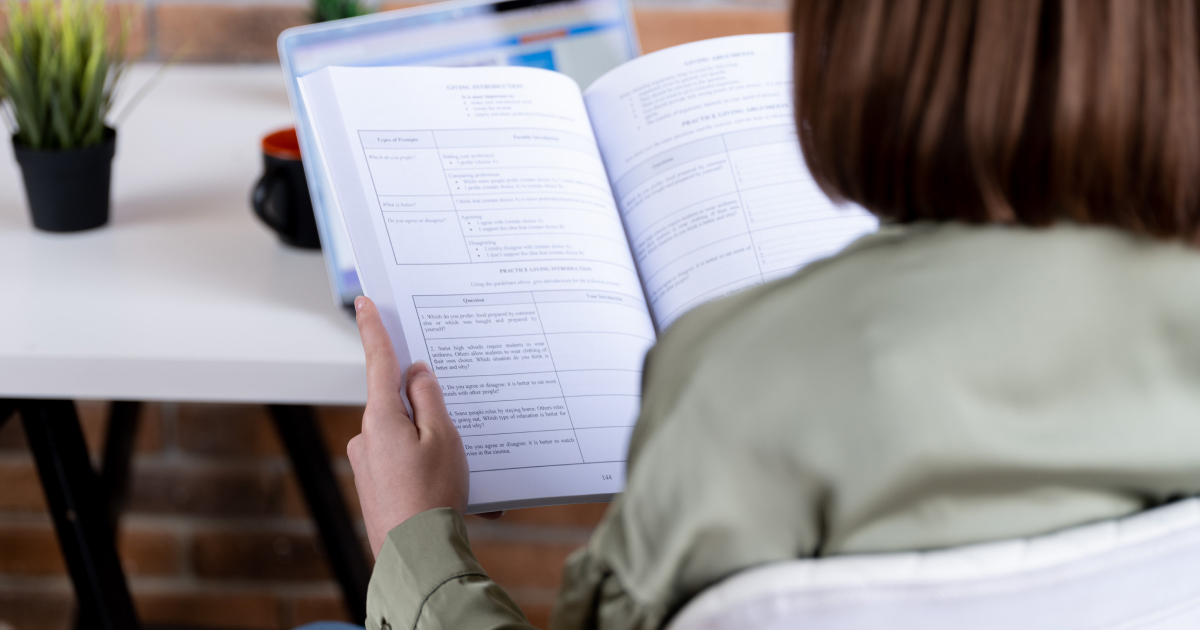Can Listening and Speaking Be Taught Through Pure Exposure?
- Speaking
- Listening
- Tips & Strategies
- Methodology

16.09.2022
What do we know about Present Continuous?
Present Continuous or Present Progressive is a tense used to describe an action that is happening at the moment of speaking and has not yet ended.
We usually teach Present Continuous to elementary students. Typically, their vocabulary is somewhat limited at this time, they know a few verbs, so there are few examples we can provide.
There is still good news. Students have already learned the verb to be, which makes it much easier for us to teach this grammatical structure.
Be a perfect ESL teacher for your beginner students
As this tense shows an action that occurs at the time of speaking, the easiest way to introduce Present Continuous to students is through performing certain actions.
For example, you can take a marker, start drawing on the board, and say:
I am drawing. Continue with other actions: I am reading, I am smiling, I am walking, etc.
There should not be many words, and they should be familiar to students. This will help them immediately understand the meaning of the grammatical structure.
Next, do the same with the 2nd and 3rd person. This is where they will need to know the forms of the verb to be.
Ask one of the students to join you, or if the lesson is online, use the pictures: I am writing. Steve is writing. We are writing.
Show students that affirmative sentences are built in the following way:
Subject + am/is/are + Verb+ing
For example:
Demonstrate as many verbs as needed. Use illustrations, photos and even videos. Ask students to say what each person or group of people is doing.

Get started with TBL
Learn with our course!Next, you need to show students how to build negative sentences in the Present Continuous. Contrast is best for this.
For example, you can take a book and say: I am reading, I am not writing. You are listening, you are not sleeping.
Show students that negative sentences are built in the following way:
Subject + am/is/are + NOT + Verb + ing or Subject + am not/ isn't/ aren't + Verb + ing
For example:
Next, ask students to do the same, always alternating affirmative and negative statements.

After, teach questions in the Present Continuous. Start with yes/ no questions, then add what, where, and so on. Model the questions:
Teacher: — Are you looking at me?
Student: — Yes!
Teacher: — Ask me!
Student: — Are you looking at me?…
Teacher: — What are you doing?
Student: — I am looking at you.
Teacher: — Ask your partner/ name!
Student: — What are you doing?…
Here it is important to draw students' attention to the difference between general and special questions. The general questions are built in the following way:
Am/ Is /Are + Subject + Verb + ing?
Dos and Don'ts of ESL teaching
In special questions the question word is placed at the beginning of the sentence, and then the order of words of the general question is kept:
What/ Where/ Why/ How…+ am / is / are + Subject + Verb + ing
Finally, move on to teaching the short answers. To do this, ask students yes/ no questions:
Are you listening to me? Yes, I am. / No, I'm not…
Next, students ask each other questions and practice giving short answers.
Presentation is the easiest and simplest way to present this grammatical structure. However, there are others.
For example, you can ask students to listen to a song and write all the verbs ending in -ing, or read the text and underline words with -ing, and so on.
Students will notice this structure, and then move on to explaining its meaning, form, and pronunciation.
The main thing to remember is that you need to create a successful and understandable context for students.

There is a lot of information and fun tasks to practise Present Continuous such as using pictures of street scenes or miming.
We have selected the most interesting ones so that you can try them with your students as soon as possible.
How to make your grammar lessons more engaging?
This fun task can be done both offline and online.
Give students sentences that need to be mimed. If it's an online lesson, you can write a sentence to a student in private messages.
It's not allowed to speak, so during an online lesson, students can turn off the sound and gesture a sentence.
Other students have to guess what it is and say or write a sentence in the chat using Present Continuous. It should match the sentence you gave the student.

It's a variant of the previous game for younger learners.
The teacher turns on the music and everyone passes the ball in a circle. When the music suddenly stops, the one who has the ball in his hands goes to the middle of the class.
The teacher shows this student a card with a picture of a certain action, which he has mime to his classmates.
The task of the rest of the class is to answer the teacher's question "What is he/ she doing?", using Present Continuous.
Prepare prompts to start each line of the postcard.
Each student fills in the first line of the card, for example, “I am writing to you from…”. The students then fold the paper so that the next person cannot see what they have written, and pass it on to the next person to continue writing the postcard.
Students continue to write and pass until they finish the postcard. Then they pass the card for the last time and open it for public reading.
Then they decide which cards make the most sense, which holiday is the best and/ or funniest.
Spice up your lessons with cool ESL resources!
Students make questions with Present Continuous. Then they toss a coin in pairs to determine who will answer and who will ask the question. The "heads" asks, the "tail'' answers.
This is more fun than it seems, because many questions in the long run are quite personal, and the person who asked the question will often be embarrassed if he has to answer his own question.
In addition, students can roll the dice to decide which tense to use in their questions (for example, Present Simple if it's one, two, or three), or a topic they should ask (for example, "Family" if it's one).

This is a task with interdisciplinary links. Give students a list of countries in different time zones. They have to write a sentence about what is probably happening there now, as well as their impressions of everyday life.
For example, "People are probably coming home from work about now. I think they work very hard, about 16 hours per day". Then students work in pairs and read their sentences to each other. The partner's task is to guess which country it is.
More ideas on ESL geography!
Students perform this task in pairs. They ask each other questions that their partner should answer with "Yes, I am".
For example, "Are you sitting?", "Are you feeling tired?" etc. They receive one point for each positive answer from their partner if no one has used this question before.
You can offer students a list of verbs, such as "wear", "think", "worry", "touch", "move", "carry" and so on. If the student answers "No, I am not", his answer is not credited to the partner.
The idea of the game is that students describe what is happening around them. The easiest way to organize this is to put one of the students in the middle of the classroom with his eyes closed. Other students ask questions using the Present Continuous.
For example, "What is our teacher doing?", "What is Anne wearing?", "What color pencil is Joanna holding?" etc.
If it is an online lesson, the student simply closes his eyes, but the camera must be turned on so that everyone can see whether he is not spying. Other students, for example, may take turns turning off their cameras and asking questions about their surroundings.
Alternatively, you can ask the student to name anything he or she can remember without asking a question. For example, 10 things that are happening right now.

As you can see, there is nothing complicated in Present Continuous if you create a good context and add a little creativity. You can adapt any of the tasks to the needs of your students. Any grammatical topic can be turned into an exciting adventure.
Students' vocabulary is not limited when Present Continuous is taught.
Presentation is the best way to explain Present Continuous to the students.
Yulia Chorna
Author
DELTA Module 1, CELTA certified teacher of General & Business English
Comments
Leave your comment